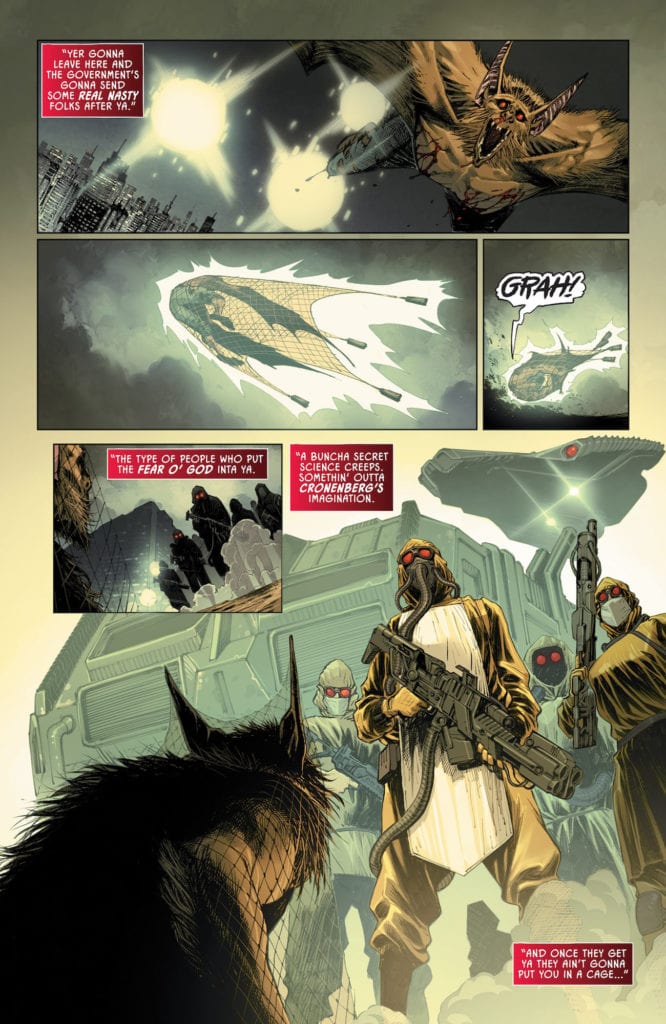Man-Bat #3 from DC Comics hits your local comic book shop on April 6. In this issue, writer Dave Wielgosz depicts the titular character’s struggle to fix his faults. The emotional stakes of the issue come from the art of Sumit Kumar. Colorist Romulo Fajardo Jr. makes some of these encounters extremely surreal, and letterer Tom Napolitano makes the voices spoken by the major characters distinct.
Man-Bat #3: The Line Between Pro/Regression
 Wielgosz really enjoys working with the characters in Man-Bat #3. Calling back to the last issue, he presents Kirk Langstrom as a character with the weight of the world on his shoulders. It’s what makes Kirk’s relationship with his monstrous alter-ego all the more interesting. Man-Bat is practically when Kirk is more honest with himself, so seeing him continuing to compartmentalize Man-Bat feels like a character regression.
Wielgosz really enjoys working with the characters in Man-Bat #3. Calling back to the last issue, he presents Kirk Langstrom as a character with the weight of the world on his shoulders. It’s what makes Kirk’s relationship with his monstrous alter-ego all the more interesting. Man-Bat is practically when Kirk is more honest with himself, so seeing him continuing to compartmentalize Man-Bat feels like a character regression.
And who better to feel the whiplash of this regression than Kirk’s ex-wife Francine and his sister Lisa? The two women care enough about Kirk despite all of the frustrations he brings to them. Not that it makes dealing with him any easier, and the reader empathizes with their frustrations. It also allows the reader to believe Francine can handle the domineering Scarecrow.
On the topic of Scarecrow, he comes across as genuinely villainous in this issue. The way he speaks feels like he is striking his victims at their psychological weak points. It’s what makes them so susceptible to Scarecrow’s fear tactics. They’re the kind of tactics that are steadily improving with each issue. The reader can’t help but dread what he’s planning for the Langstroms.
Expressive Art Doesn’t Hide
 Kumar illustrates Man-Bat #3 with a host of expressive visuals confined to split-second panel work. In just two similarly drawn panels, it emphasizes how a quick moment changes everything. Whether it’s Francine’s shocking encounter with Scarecrow or Lisa’s blank surprise at her brother, the reactions serve as stories of their own.
Kumar illustrates Man-Bat #3 with a host of expressive visuals confined to split-second panel work. In just two similarly drawn panels, it emphasizes how a quick moment changes everything. Whether it’s Francine’s shocking encounter with Scarecrow or Lisa’s blank surprise at her brother, the reactions serve as stories of their own.
The color by Fajardo gives several of these scenes a surreal presence. The way Kirk looks at a family photo with a silhouette of his face feels disheartening. It makes Kirk look like a ghost to his own family.
Napolitano’s lettering displays a very fitting narrative weight. The way Man-Bat speaks in Kirk’s mind through black captions is loud, rough, but honest. In comparison, Kirk’s own inner monologues with the smooth gray captions display him holding Man-Bat back, including the honesty.
Bring On Man-Bat #3
Man-Bat #3 continues a gripping saga of the struggles of delusion. Kirk may be a sympathetic character, but Man-Bat is looking more heroic the less he appears because at least the monster acknowledges the strength of everyone around him.

